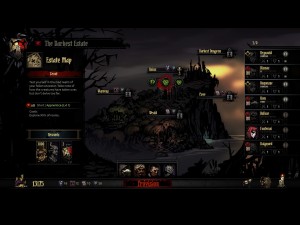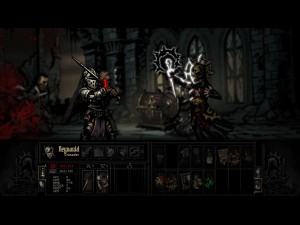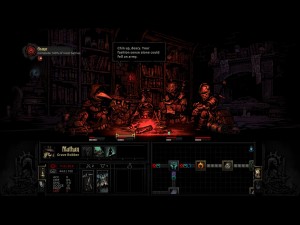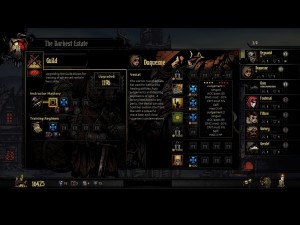Last year the Darkest Dungeon was one of the most impressive kickstarters I saw and became a runaway hit for the platform. After an interview that was separated into part 1 and part 2, I finally had a chance to sit down with the game. Darkest Dungeon is every bit as brutal and demanding from the kickstarter trailer and whether or not that’s a turn on or turn off is going to be up to you.
(This spotlight is based on the Early Access version of the game. Screenshots and impressions may not match the current version. The developers are planning for six months of working on the game in Early Access before releasing it.)
A Motley Crew:
The story of the Darkest Dungeon is that you are the last in the line of a once proud family who owned a huge estate. When your predecessor went mad and unearthed an ancient evil, the estate and neighboring hamlet became cursed and it’s now up to you to reclaim the land with the help of anyone heroic or foolish enough to join.
Darkest Dungeon is a party based RPG and “you” will not take part in battles but instead manage your team. The tutorial introduces you to two of the fifteen playable classes that you can form your party with. Each potential teammate features assigned stats, random character traits and a selection of the class’s unlocked skills. Character traits come in both positive and negative forms and characters can get new ones as they survive the horrors of the dungeon.
Each class is completely unique from one another, from the holy crusader to the plague doctor in terms of utility. The skills that make up a class allow them to be better in different positions during combat which we’ll talk about next.
The hamlet itself acts as your base of operations and progression model for the Darkest Dungeon. The different buildings provide various services and become unlocked through play.
Finding mementos and treasures during a quest become currency that can be used to upgrade the buildings which in turn improve their effects and usage.
The quests themselves are procedurally generated around different types and lengths with more becoming available overtime. Once you’ve chosen a quest and party formation, you can buy provisions which act as emergency items during play including the very important torches and food. While questing, your torch meter will gradually decline and the darker it gets, the more dangerous and rewarding your quest becomes. Food is needed to avoid starving and can be used for emergency healing.
Once combat begins, the Darkest Dungeon really hits you both physically and mentally.
Maddening Combat:
The combat system is tactical with a focus on positioning. As mentioned above, different skills can be used at various ranges which can impact the character’s utility and the same goes for the enemies. Both parties line up and the teams will shift based on any killed members or certain skill effects.
Death in the Darkest Dungeon is permanent; however you have one safety net in the form of “death’s door.” When a character runs out of health, they’ll die if they are not healed before they take any more damage. This will give you a chance to heal someone and makes the permanent death system a little more forgiving.

Quests are procedurally generated that determine their length, type and rewards while the area affects what enemies will be waiting for you.
Status aliments are very important in the game as you can stun, bleed and more to enemies and they can do the same to you. But the worse thing to happen to your team involves their sanity. Besides health, every character has a stress meter which fills as things go from bad to worse during a quest.
When the meter fills up, the characters hits their breaking point and will either succumb and get a negative trait or rise up and get a positive trait. The chance is completely random and can make or break your run, from becoming valiant, masochistic, paranoid and a lot more can impact things.
You can leave a dungeon and forfeit any remaining treasure if things get too rough but the only way to unlock new areas is to complete the quests. While health gets restored, stress levels and broken negative traits remain unless you let that character recover in one of the buildings in town. Different characters may respond better or worse to certain treatments or may be forced into specific ones based on traits.
The combat system is really well done as it forces you to make tough choices while rewarding you for setting up group and skill dynamics. You can only have four combat skills equipped at once which in turn allows you to uniquely define that character for certain situations. You could make a Vestal that is all about front line attacks or a healer/holy spellcaster that stays in the back.
Each area features different enemies to deal with which also affects who you should bring. For instance skeletons are immune to bleeding which makes the highwayman’s knife attack not as good compared to when he’s facing living enemies. Enemies are also split between those that focus on damage vs. those that raise stress and part of the challenge of the game is figuring out who to focus on first and how to take them out quick.
Everything tied together gives the Darkest Dungeon a very unique feel to it and reminds me a lot of X-Com in how you really need to care about the bigger picture rather than your individual characters. Progress is not given but earned and you’re going to lose a lot of teammates in the process.
Combined with the amazing art aesthetic, music and gravelly voiced narrator really brings the package together. But one area where the Darkest Dungeon may fail to attract people at the moment is the difficulty which swings between brutally difficult and cheap difficult.
Bloodied and Bruised:
The Darkest Dungeon is a very demanding game and was explicitly designed as such. This is a lot like X-Com where success is going to require a lot of failures along the way.
Right now the balance of the game is definitely tilted against the player. It’s very hard to recover health and sanity and one critical hit at a bad time can really spell doom for your party. Having one character break during a quest can set off a chain of events that dooms your party as that person can cause stress damage to the other teammates and make them break as well.
Starting out you won’t have the money or items to keep everyone going and upgraded and just like in X-Com you will have to sacrifice a lot of your teammates for the greater good. Run out of gold early on due to unlucky quests and it’s very hard to recuperate . All items that you buy before a quest will be removed from your inventory even if you don’t use them after a quest is done.
It can feel sometimes that you are taking two steps forward and three steps back and there are plenty of situations where you are just screwed because of the RNG. For instance one time I got hit by four critical hits in the very first battle of a quest with every party member near death before the battle was over and there was nothing I could have done differently. I know there are people out there who don’t like losses that are out of their control or the feeling of losing progress which is pretty much the X-Com experience.
Speaking of progress, the randomize nature of the dungeons and characters can also make it hard for new players to figure out what to do first.
It sucks to spend gold and treasures to upgrade for new weapons to only have that character die the very next run and then have to get another character and repeat the process.
Another confusion point is trying to figure out what skills to build parties around which is also tough due to gold demands at the start.
A good tip by the designer is to focus on upgrading your caravan first as it will allow you to get more recruits after each quest and have more space to keep the ones you want.
My suggestion is to play a few games with the purpose of just messing with everything before committing to an actual play with the knowledge that you’ve picked up. Another comparison to X-Com is that the game becomes easier once you get past that initial hump of starter characters thanks to meta game improvements through upgrades and you should treat your first party as red shirts if you know what I mean.
The only technical or UI issues I have with the game at the moment are that some of the description texts for skills are a bit hard to read such as seeing pluses and minuses which in this game can be a very big deal. And that the game could use a bit more information such as any special class advantages and buff/debuff duration.
Freaking Out:
The Darkest Dungeon is an impressive game and one that I really hope goes far. This is one of those titles that hit so many points of what I want in a game from a gameplay and aesthetic angle that it’s tough for me to not play it while Red Hook finishes up. Right now the main concern with the game is balancing and the developers have already said that they are closely monitoring the game.
Even with the game just entering early access and its current state, the Darkest Dungeon is amazing and I’m sure will be on a lot of game of the year lists for 2015.





